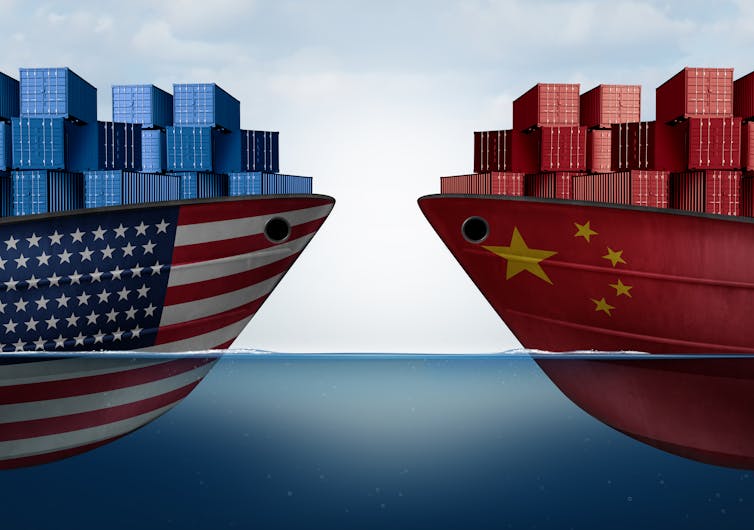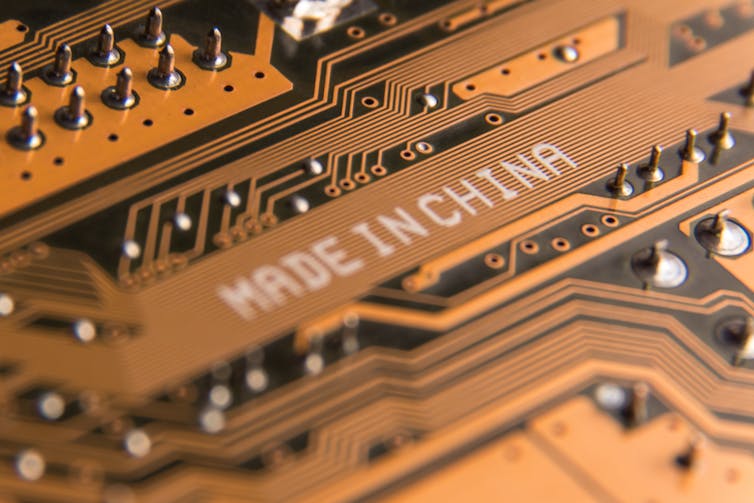How Chinese products went from cheap and cheerful to weapons in US trade war – CWEB.com

shutterstock.com
Qing Shan Ding, University of Huddersfield
Tensions are escalating between China and the US over trade. The Chinese government has announced retaliatory measures on a range of American products including cars and some American agriculture products after the US listed 1,333 Chinese products to be hit by punitive tariffs of 25%.
Yet a trade war does not make economic sense for either side. Bilateral trade between the US and China was worth about US$711 billion in 2017 and Boeing’s single deal with China signed during Donald Trump’s visit to Beijing in 2016 was worth about US$37 billion alone.
The jobs and livelihoods at risk are huge. So why is there no particular desire, especially from Trump, to ease the tension and find a new solution?
There has been much talk about the US trade deficit with China and allegations that China steals US intellectual property. But the answer could lie in US fears of the Chinese government’s “Made in China 2025” initiative and how it signals the growing threat of China as an economic rival. That the official US Trade Representative’s recent investigation into Chinese trade practices mentioned the Made in China 2025 initiative more than 100 times, suggests this is the case.
Image problems
Made in China 2025 was launched by the Chinese government in 2015 to upgrade the country’s manufacturing capabilities. It is a plan to transform what China produces from a low-cost, labour-intensive model to advanced and smart manufacturing. Certain key industries such as aerospace, robotics and high-tech medical equipment have been prioritised. The hope is that China will gradually match developed countries’ manufacturing capabilities and become industry leaders.
A lot of the products from these key industries, such as industrial robots, aviation and aerospace equipment, new energy and power supplies and advanced rail machinery were all included in the tariff target list published by the US Trade Representative. So it would seem that the current situation is not simply a trade issue aimed to reduce America’s trade deficit with China. Instead, it is likely targeted at the future competition China will pose.

shutterstock.com
China’s Made in China 2025 strategy makes perfect sense in my field of research, which concerns where products are manufactured and how this effects their popularity in the global market place. A strong and positive image of a country can generate what economists call “halo effects” on its products. So, Germans have built good reputations for their cars and engineering, France and Italy for their wine and fashion, and the US for their innovative products.
This worldwide reputation brings with it prestige and higher price premiums. Although there is still debate around whether brand origin could be more important than where the product is produced (Apple, for example designs its products in the US but manufactures them in China), there is no doubt that “Made in China” suffers from an image problem.
Chinese products have long been associated with a cheap and cheerful perception that they are not good in terms of quality or ingenuity. The Chinese government has long been aware of this view and keen to change it.
At the turn of the 21st century, it set up a policy called “Going Out” to encourage leading Chinese firms to expand internationally, acquire new technology and the tools to innovate. The two big examples were IT firm Lenovo’s takeover of IBM’s personal computer division in 2005 and Geely automotive’s purchase of Volvo in 2010. Made in China 2025 serves the same purpose — to boost China’s technology and innovation capabilities and to improve the image of Chinese products.
Impressive growth
There is no doubt that China has come a long way since the 1990s. It has built 22,000km of advanced high speed rail network within the last decade, which is more than the rest of the world combined. It is also considered as the global leader in renewable energy and technology, patent filings, commercial drones, industrial robotics and e-commerce and mobile payments.

shutterstock.com
Chinese telecommunications company Huawei typifies the transformation of Chinese products in recent years. Within the last decade, Huawei has surpassed Ericsson and Nokia to become the world’s biggest telecom equipment supplier and has just overtaken Apple as the world’s second largest smartphone maker, behind Samsung.
[youtube https://www.youtube.com/watch?v=9TXBP1t2rUc&w=560&h=315]
What’s more remarkable about these statistics is that Huawei has transformed itself from a cheap phone maker to an accepted premium brand that can compete with Apple and Samsung. Its latest releases the top of the range Huawei P20 Pro will retail for US$1,100 and its top end model Huawei Porsche Design Mate RS will sell for US$2,109 — even more than the iPhone X.
![]() There is no doubt that some in the US are uncomfortable with China’s impressive growth and feel threatened by it. It suggests the current trade dispute is not just about imports and exports, but also an incumbent superpower feeling the threat of a growing challenger.
There is no doubt that some in the US are uncomfortable with China’s impressive growth and feel threatened by it. It suggests the current trade dispute is not just about imports and exports, but also an incumbent superpower feeling the threat of a growing challenger.
Qing Shan Ding, Senior Lecturer in Marketing, University of Huddersfield
This article was originally published on The Conversation.


